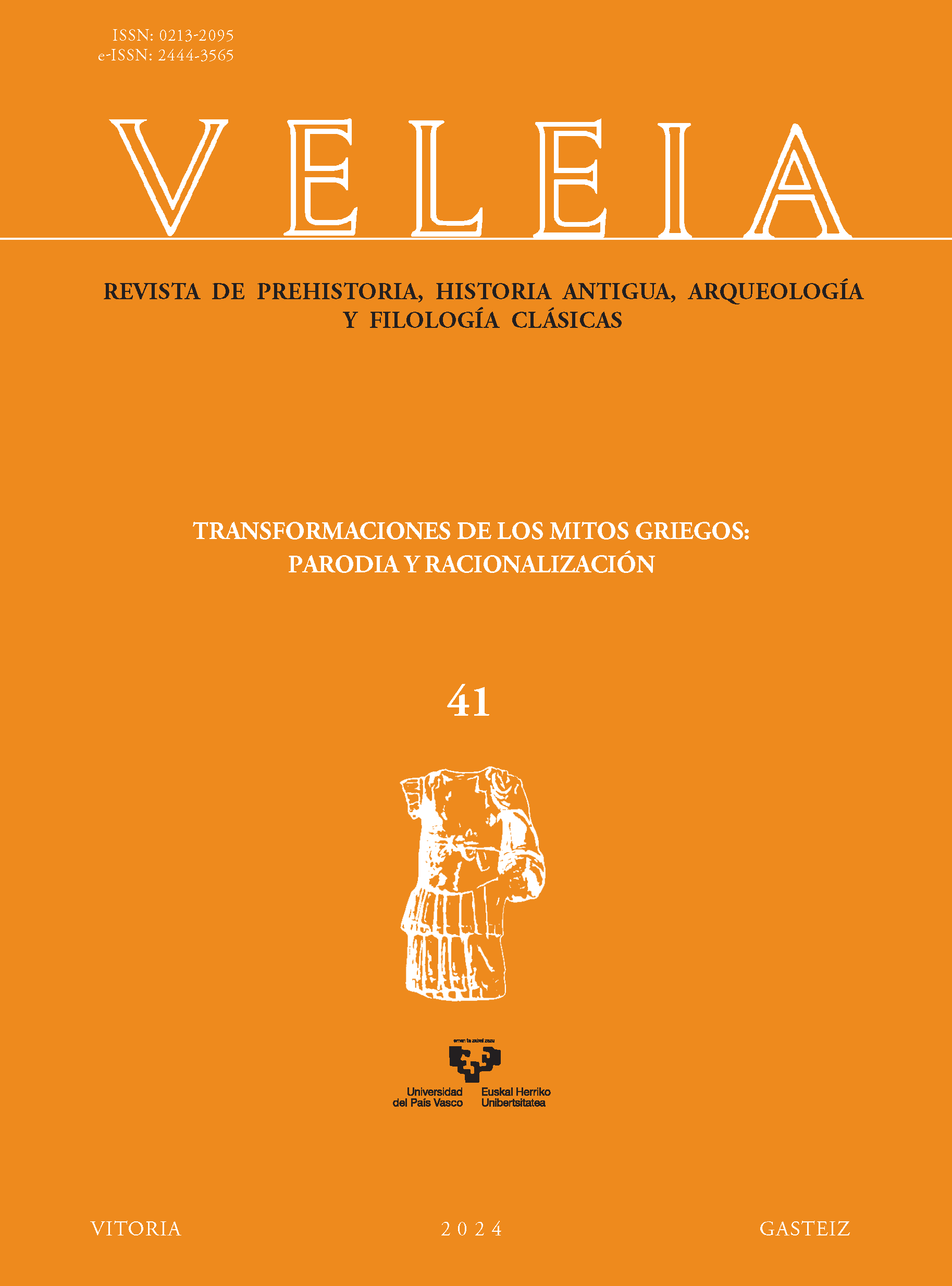Perséfone y la dureza del trabajo según Cornuto (ND 46,1-3 Torres) y el estoicismo
##plugins.themes.bootstrap3.article.main##
##plugins.themes.bootstrap3.article.sidebar##
Resumen
Este trabajo revisa primero las etimologías modernas y antiguas de Perséfone. Se llama la atención sobre el hecho de que el Repaso de las tradiciones teológicas de los griegos del estoico Cornuto etimologiza de manera peculiar el teónimo en 46,1-3 Torres. Por una parte, este es el único caso conocido en el que -φόνη, la segunda parte de Περσεφόνη, se relaciona con πόνος, el ‘trabajo duro’. Después, Cornuto emplea esta explicación etimológica como base para una alegoría doble según la cual Perséfone simboliza el trabajo duro que supone el laboreo del campo; o bien su nombre es un recordatorio de que la práctica de un trabajo esforzado genera aguante. Tras revisar el concepto de ‘trabajo’ presente en otros escritos estoicos, se hace observar que, para una comprensión adecuada del pasaje analizado, se deben tener en mente el carácter didáctico del manual de Cornuto, lo que este declara en otros lugares sobre el trabajo intelectual, así como un pasaje relevante de Persio.
Descargas
##plugins.themes.bootstrap3.article.details##
Applebaum, H., 1995, «The Concept of Work in Western Thought», en: F. C. Gamst (ed.), Meanings of Work: Considerations for the Twenty-First Century, Albany: State University of New York Press, 46-78.
Beekes, R. S. P., 2009, Etymological Dictionary of Greek, Leiden: Brill.
Berdozzo, F., 2009, «Einführung in die Schrift», en: H. G. Nesselrath (ed.), Cornutus. Die Griechischen Götter: ein Überblick über Namen, Bilder und Deutungen, Tübingen: Mohr Siebeck, 3-28.
Bernabé, A., 2005, Poetae epici graeci testimonia et fragmenta. II. Orphicorum et orphicis similium testimonia et fragmenta. 2, Munich-Leipzig: Saur.
Boys-Stones, G., 2003, «The Stoics’ Two Types of Allegory», en: G. Boys-Stones (ed.), Metaphor, Allegory, and the Classical Tradition: Ancient Thought and Modern Revisions, Oxford: Oxford University Press, 189-216.
Boys-Stones, G., 2007, «Fallere sollers: The Ethical Pedagogy of the Stoic Cornutus», BICS (Suppl. 94), 77-88.
Boys-Stones, G., (ed. y trad.), 2018, L. Annaeus Cornutus: The Greek Theology, Fragments and Testimonia, Atlanta: SBL Press.
Bremmer, J. N., 2013, «Divinities in the Orphic Gold Leaves: Euklês, Eubouleus, Brimo, Kybele, Kore and Persephone», ZPE 187, 35-48 (ahora en: J. N. Bremmer, The World of Greek Religion and Mythology. Collected Essays II, Tübingen: Mohr Siebeck, 2019, 61-84).
Burkert, W., 2011, Griechische Religion der archaischen und klassischen Epoche, Stuttgart: Kohlhammer.
Chantraine, P., 1983-1984, Dictionnaire étymologique de la langue grecque: Histoire des mots, Paris: Klincksieck.
Craig, N., 2020, «Work as an Obligation», en: R. Skidelsky & N. Craig (eds.), Work in the Future: The Automation Revolution, Cham: Springer International Publishing, 73-80.
Domaradzki, M., 2011, «Theagenes of Rhegium and the Rise of Allegorical Interpretation», Elenchos 32, 205-227.
Domaradzki, M., 2012, «Theological Etymologizing in the Early Stoa», Kernos 25, 125-148.
Domaradzki, M., 2017, «The Beginnings of Greek Allegoresis», CW 110, 299-321.
Edelstein, L., 1966, The Meaning of Stoicism, Cambridge, MA: Harvard University Press.
Frisk, H., 1960-1970, Griechisches etymologisches Wörterbuch, Heidelberg: Winter.
Lang, C., (ed.), 1881, Cornuti Theologiae Graecae Compendium, Leipzig: Teubner.
Manutius, A., (ed.), 1505, Habentur hoc uolumine haec (…). Phurnutus, seu, ut alii, Curnutus de natura deorum (…), Venetiis: apud Aldum.
Most, G. W., 1989, «Cornutus and Stoic Allegoresis», ANRW II 36.3, 2014-2065.
Most, G. W., 2015, «Allegoresis and Etymology», en: A. Grafton & G.W. Most (eds.), Canonical Texts and Scholarly Practices: A Global Comparative Approach, Cambridge: Cambridge University Press, 52-74.
Nesselrath, H. G., (ed.), 2009, Cornutus. Die Griechischen Götter: ein Überblick über Namen, Bilder und Deutungen, Tübingen: Mohr Siebeck.
Ramelli, I., (ed. y trad.), 2003, Anneo Cornuto. Compendio di teologia greca, Milano: Bompiani.
Ramelli, I., 2018, «Annaeus Cornutus and the Stoic Allegorical Tradition: Meaning, Sources, and Impact», AITIA 8.2 (https://journals.openedition.org/aitia/2882).
Ramelli, I., 2022, «Stoic Homeric Allegoresis», en: C.-P. Manolea (ed.), Brill’s Companion to the Reception of Homer from the Hellenistic Age to Late Antiquity, Leiden: Brill, 229-258.
Ramelli, I., & G. A. Lucchetta, 2004, Allegoria. I. L’età classica. Milano: V&P Università.
Richardson, N. J., (ed.), 1974, The Homeric Hymn to Demeter, Oxford: Clarendon Press.
Sluiter, I., 2015, «Ancient Etymology: A Tool for Thinking», en: F. Montanari, S. Matthaios, A. Rengakos (eds.) Brill’s Companion to Ancient Scholarship. Leiden: Brill, 896-922.
Torres Guerra, J. B., (trad.), 2005, Himnos Homéricos, Madrid: Cátedra.
Torres Guerra, J. B., 2010, «Mitos didácticos. El significativo caso de Aneo Cornuto», en: E. Borrell Vidal, P. Gómez Cardó (eds.), Artes ad Humanitatem, Barcelona: Secció Catalana de la SEEC-Diputació de Tarragona. Vol. I, 95-101.
Torres Guerra, J. B., (ed.), 2018, Lucius Annaeus Cornutus. Compendium de Graecae Theologiae traditionibus, Berlin: Walter de Gruyter.
Wachter, R., 2006, [Reseña de Lexikon des frühgriechischen Epos (LfgrE), fascs. 19 and 20], Kratylos 51, 136-144.
Wachter, R., 2007/2008, «Persephone, the Threshing Maiden», Die Sprache 47,2, 163-181.
Zucker, A., & C. Le Feuvre, 2021, «Introduction», en: A. Zucker, C. Le Feuvre (eds.), Ancient and Medieval Greek Etymology. Theory and Practice. I [Trends in Classics. Supplementary Volumes, 111], Berlin-Boston: Walter de Gruyter, 1-18.

Esta obra está bajo una licencia internacional Creative Commons Atribución-NoComercial-SinDerivadas 4.0.
A no ser que se indique lo contrario, los contenidos de la edición electrónica de la plataforma OJS se regulan por una licencia de uso y distribución Creative Commons Atribución-NoComercial-SinDerivadas 4.0 Internacional (CC-BY-NC-ND).
La revista no cobra ninguna compensación económica a los autores por publicar en ella y da total acceso a los archivos sin ningún tipo de embargo desde el día de su publicación electrónica. Se respeta así la política nacional de acceso abierto.
Todos los originales publicados en la revista Veleia, ya sea en su formato impreso o en el digital, son propiedad de la Universidad del País Vasco (UPV/EHU). © UPV/EHU
Los autores de artículos (sean artículos de investigación, noticias, varia o reseñas) podrán acceder a sus propias obras en la página web de la revista. Los autores podrán colocarlos en sus repositorios personales y cuentan también con la posibilidad de difusión pre-print de los artículos ya admitidos para publicar.

